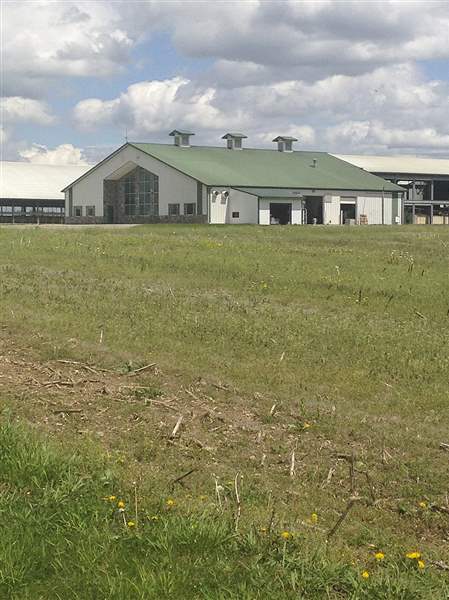
Tour of CAFO sites prompts debate
Group: More attention must be paid to tiny dissolved reactive phosphorus
5/2/2017
Pam Taylor says that each cow at CAFOs such as this one produces the manure equivalent of more than 20 humans.
THE BLADE/TOM HENRY
Buy This Image
HUDSON, Mich. — Twenty-one people participated in an extensive driving tour Monday around concentrated animal feeding operations — or CAFOs — on Monday.
Attendees included Lucas County Treasurer Wade Kapszukiewicz and Ohio Rep. Michael Sheehy (D., Oregon). It was the second annual CAFO tour sponsored by Advocates for a Clean Lake Erie, founded by Mike Ferner, an ex-mayoral hopeful and councilman.
The discussion was led by Pam Taylor, a retired schoolteacher who’s part of Environmentally Concerned Citizens of South Central Michigan, which has gained global attention for its CAFO watchdog efforts. One of the group’s founders, Lynn Henning, was North America’s winner of the 2010 Goldman Prize, the world’s most prestigious for environmental activism.
Ms. Taylor said she wants people to “understand what happens far upstream in the headwaters.”
More focus, she said, should be put on the smallest forms of liquid phosphorus dissolved in the water, because it makes algae grow faster than traditional particles. Most dissolved reactive phosphorus is too small to be filtered out and winds up in western Lake Erie ditches via underground drainage tiles the public usually doesn’t see, she said.
“There just doesn’t seem to be the will to address the big problems,” Ms. Taylor said. She likened CAFOs to “little cities” because of the enormous volume of manure they produce. Each cow produces the manure equivalent of more than 20 humans.
Most algae-control efforts are hyperfocused on surface runoff. But scientists at Ohio State University and other institutions agree the effect from underground drainage tiles has been largely overlooked.
Ms. Taylor said more attention must be paid not just to the volume coming out of the tiles, but the amount of dissolved reactive phosphorus. Windbreaks, buffer strips, and cover crops do little to stop liquid manure containing dissolved reactive phosphorus from pouring from the drainage tiles, she said.
“That goes where the water goes,” she said. “This is an emergency right now. We cannot apply as much manure to the ground as we’ve been doing.”
John Klein, a Toledo native who co-founded the group and is its president, said he has been working with Michigan regulators to pinpoint nutrients forming the algal toxin microcystin — the same one in Lake Erie — in small, idyllic Lime Lake.
Two CAFOs are nearby. Lab tests have shown swine, bovine, and human DNA in the water, Mr. Klein said.
“I look at this as a small scale of what’s happening in Grand Lake St. Marys and Lake Erie,” he said.
Contact Tom Henry at: thenry@theblade.com, 419-724-6079, or via Twitter @ecowriterohio.